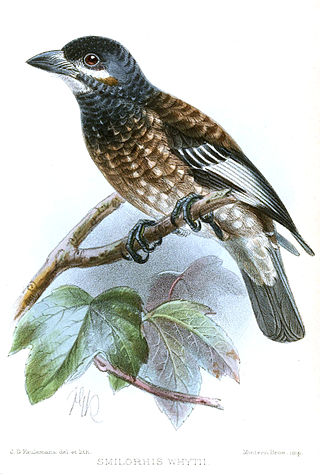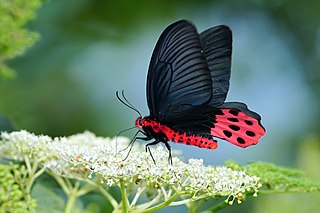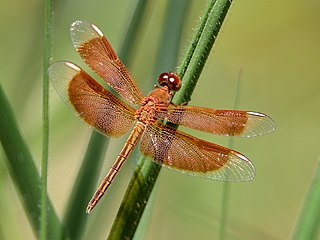
The African golden cat is a wild cat endemic to the rainforests of West and Central Africa. It is threatened due to deforestation and bushmeat hunting and listed as Vulnerable on the IUCN Red List. It is a close relative of both the caracal and the serval. Previously, it was placed in the genus Profelis. Its body size ranges from 61 to 101 cm with a 16 to 46 cm long tail.

The chasers, darters, skimmers and perchers and their relatives form the Libellulidae, the largest family of dragonflies. It is sometimes considered to contain the Corduliidae as the subfamily Corduliinae and the Macromiidae as the subfamily Macromiinae. Even if these are excluded, there remains a family of over 1000 species. With nearly worldwide distribution, these are almost certainly the most often seen of all dragonflies.

The snowcocks or snowfowl are a group of bird species in the genus Tetraogallus of the pheasant family, Phasianidae. They are ground-nesting birds that breed in the mountain ranges of southern Eurasia from the Caucasus to the Himalayas and western China. Some of the species have been introduced into the United States. Snowcocks feed mainly on plant material.

The common dab is an edible flatfish of the family Pleuronectidae. It is a demersal fish native to shallow seas around Northern Europe, in particular the North Sea, where it lives on sandy bottoms down to depths of about 100 metres (330 ft). It can reach 40 centimetres (16 in) in length and can weigh up to 1 kilogram (2.2 lb), though most specimens grow no longer than 20 centimetres (7.9 in).

The Angolan slender mongoose is a mongoose native to southwestern Africa, specifically southwestern Angola and northwestern Namibia. It has been listed as Least Concern on the IUCN Red List, as it is not threatened and thought to be common. It has a long, slim body and there are different colour forms, a black or dark brown form in the southern part of its range, and a yellowish- or reddish-brown form in the north. This mongoose inhabits dry, rocky habitats and feeds on insects, scorpions and small vertebrates.

Neurothemis tullia, the pied paddy skimmer, is a species of dragonfly found in south and south-east Asia. It appears in Bangladesh, China, Hong Kong, India, Malaysia, Myanmar, Nepal, Sri Lanka, Taiwan, Thailand, Cambodia and Viet Nam.

The red climbing mouse, also known as Vernay's climbing mouse, is a species of rodent in the family Muridae. It is named after explorer and antiques dealer, Arthur Vernay, who sponsored the expedition during which the animal was first discovered. It is the only living species in the genus Vernaya, and has no subspecies.
The Iranian ground jay or Pleske's ground jay, is a species of bird in the family Corvidae. It is endemic to Iran where it is known as Zaghbur in Persian.

Whyte's barbet is a species of bird in the family Lybiidae. It is found in Malawi, Mozambique, Tanzania, Zambia, and Zimbabwe.

The sharp-snouted rock lizard is a species of lizard in the family Lacertidae. It is found in Bosnia and Herzegovina, Croatia, Montenegro, and possibly Albania, where its natural habitats are Mediterranean-type shrubby vegetation, rocky areas, rocky shores, rural gardens, and urban areas.

The Guayaquil squirrel is a tree squirrel endemic to Ecuador and Peru. It is a robust squirrel with a head-and-body length of 18 to 32 cm and a similar length tail. The colour is variable; in Peru, a pale morph is more common, while in Ecuador, most individuals have darker grey fur on the forequarters, dull orange hindquarters. A melanistic morph is sometimes seen. It lives largely in trees and is diurnal, feeding on seeds, flowers, and other plant material, fungi and some insects. These squirrels are also found in urban areas, living in close proximity to humans, and may be vectors for leptospirosis and Chagas disease. This squirrel faces no particular threats, has a wide range and is relatively common, and the International Union for Conservation of Nature has rated it as being of "least concern".

The Asia Minor ground squirrel, also known as Anatolian souslik, Anatolian ground squirrel, is a species of rodent in the family Sciuridae. It is found in Armenia, Iran, and Turkey. The scientific name roughly translates as "seed-lover with yellow underparts".

The Guianan bonneted bat, or Thomas's mastiff bat, is a species of free-tailed bat from South America. It is poorly understood, because it is difficult to capture, and may be one of the rarest Neotropical bats.

The Malayan weasel or Malay weasel is a weasel species native to the Malay Peninsula and the islands of Sumatra and Borneo. It is listed as Least Concern on the IUCN Red List.
Terminalia ivorensis is a species of tree in the family Combretaceae, and is known by the common names of Ivory Coast almond, idigbo, black afara, framire and emeri.

Atrophaneura horishana, the aurora swallowtail, is a species of butterfly from the family Papilionidae that is found in Taiwan.

Neurothemis stigmatizans, known as the painted grasshawk, is an Australian species of dragonfly in the family Libellulidae. The genus Neurothemis is distributed from India to the western Pacific. This species is found in northern Australia in an arc from the southern Queensland border to Broome, Western Australia.

Neurothemis fluctuans, the red grasshawk, common parasol or grasshawk dragonfly, is a species of dragonfly in the family Libellulidae. It is widespread in many Asian countries.

Neurothemis intermedia, the paddyfield parasol, is a species of dragonfly in the family Libellulidae. It is widespread in many Asian countries. Four subspecies are recognized.

The Amur paradise flycatcher is a bird species in the family Monarchidae. It is native to China and Primorsky Krai in the Russian Far East. It is a winter migrant to Southeast Asia. Until 2015, it was considered as a subspecies of the Asian paradise flycatcher.




















